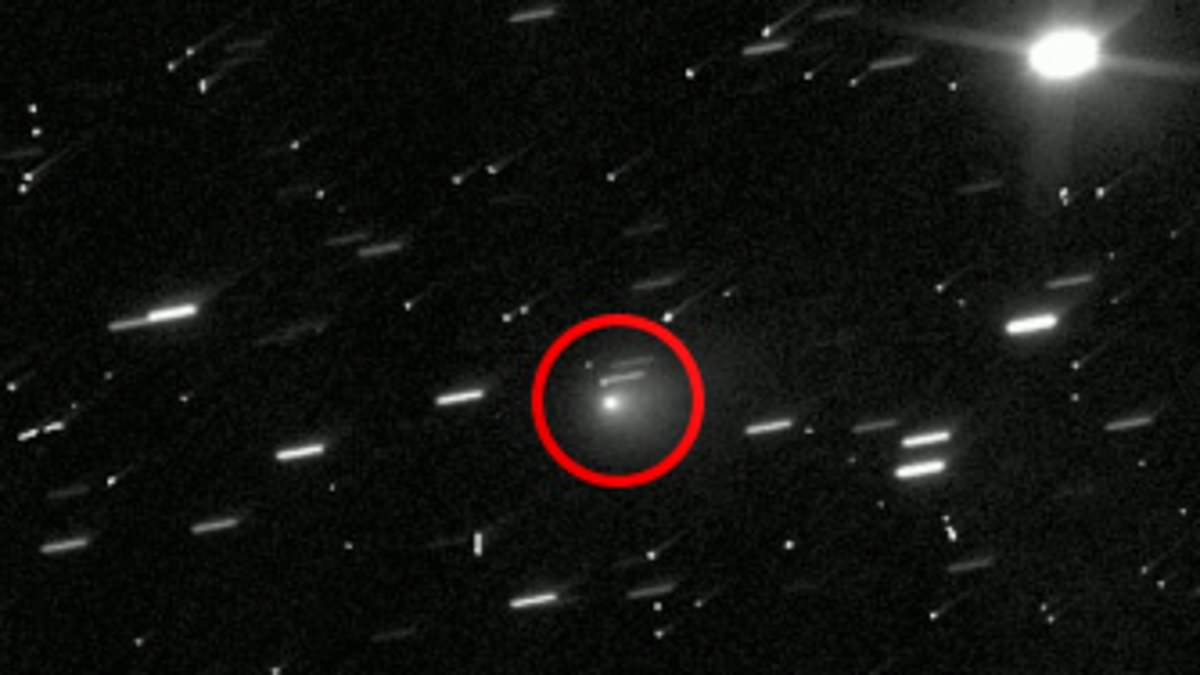A respected Harvard astrophysicist has revealed new evidence suggesting that the mysterious object barreling toward Earth this December is an alien craft.
Professor Avi Loeb and his team found that the supposed comet known as 3I/ATLAS is on an extremely unusual course that will take it close to three different planets: Venus, Mars, and Jupiter.
Loeb explained that 3I/ATLAS’s course is so rare the chance of a natural space rock randomly flying along that path is less than 0.005 percent.
Based on those findings, Loeb, an outspoken believer in UFOs, has concluded that 3I/ATLAS may be an alien probe sent to this solar system by an unknown intelligence.
Moreover, Loeb said that such a craft and the beings who control it would have one of two motives, one being harmless and the other being hostile.
‘The consequences, should the hypothesis turn out to be correct, could potentially be dire for humanity, and would possibly require defensive measures to be undertaken (though these might prove futile),’ Loeb and his team warned in their new study.
The researchers’ theory emerged from a grim scientific concept called the dark forest hypothesis, which assumes that other intelligent civilizations in the galaxy would be hostile and likely view humanity as a threat that needs to be attacked.
In 2021, Loeb theorized that Oumuamua, the first interstellar object which passed through our solar system, may have also been an alien probe, citing its strange cigar-like shape and its ability to speed up without the influence of gravity.

Telescopes have been tracking the course of 3I/ATLAS as it travels through our solar system in 2025 and 2026

The interstellar object (circled) is believed to be a comet, but Harvard astrophysicist Avi Loeb contends it could be an alien craft
In May, Professor Loeb was one of the keynote speakers at a congressional hearing regarding UFO sightings. At that event, he said ‘there are objects in the sky that we don’t understand’ while calling for increased funding for UFO detection.
Loeb has also claimed that up to 10 percent of the metal fragments recovered from the Pacific Ocean contain ‘alien’ elements not seen in our solar system.
Those remnants came from a meteor-like object that originated from interstellar space and crashed off the coast of Papua New Guinea in 2014. However, Loeb has maintained that the object could have been an alien craft, or at least debris from one.
This month, Loeb and co-authors Adam Drowl and Adam Hibberd from the space research non-profit Initiative for Interstellar Studies found other pieces of evidence that suggest 3I/ATLAS is not your average comet.
First, its massive size, which studies estimate as between seven and 12 miles long, would make it significantly larger than Oumuamua (300 to 1,300 feet long).
Scientists have said that interstellar objects that large should be extremely rare in the cosmos, making 3I/ATLAS’s visit to our solar system a statistical long-shot.
Loeb’s study also revealed 3I/ATLAS does not have a coma, a cloud of gas and dust that typically surround comets.
The team said this suggests the giant object is therefore not a comet, which should have a smaller core and be part of a larger population of interstellar objects.

3I/ATLAS is projected to make close passes by 3 different planets: Venus, Mars, and Jupiter

3I/ATLAS (circled) is expected to make its closest approach to Earth on December 17, 2025
Read More
'Men disguised as police' attempt to steal sphere-shaped UFO after new information is revealed

Combined with the one-in-20,000 chance of making close passes by multiple planets this year, Loeb argued the possibility that the object headed toward Earth could be artificial can’t be ignored.
‘When viewed from an open-minded and unprejudiced perspective, these investigations have revealed many compelling insights into the possibility that 3I/ATLAS is technological,’ Loeb explained.
Their new study was published to the pre-print server arXiv on July 17, meaning the research has not been peer-reviewed yet.
Whether it’s a comet or an alien craft, 3I/ATLAS is expected to pass by Earth on December 17, speeding through the solar system at more than 41 miles per second (roughly 150,000 miles per hour).
On its current trajectory, it’ll come within 2.4 astronomical units of our planet (223 million miles).
An astronomical unit (AU) is equal to the distance between Earth and the sun, 93 million miles. Technically, 3I/ATLAS has been in the solar system for weeks, and was roughly four AU away from Earth in early July.

Loeb also suggested that Oumuamua, an interstellar object which passed Earth in 2017, may have also been an alien probe
In October, it’ll make its closest approach to a planet, coming within 0.4 AU (37 million miles) of Mars.
Loeb’s previous analysis of the massive object has found that it has come from a thicker part of the Milky Way galaxy’s disk, where older stars are found.
The 12-mile-wide visitor is believed to be older than our sun, which is 4.6 billion years old.
The July 10 study in Astronomy & Astrophysics found 3I/ATLAS took about 800 million years to travel across part of the Milky Way to reach our solar system.
